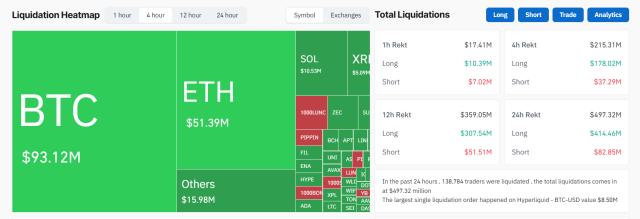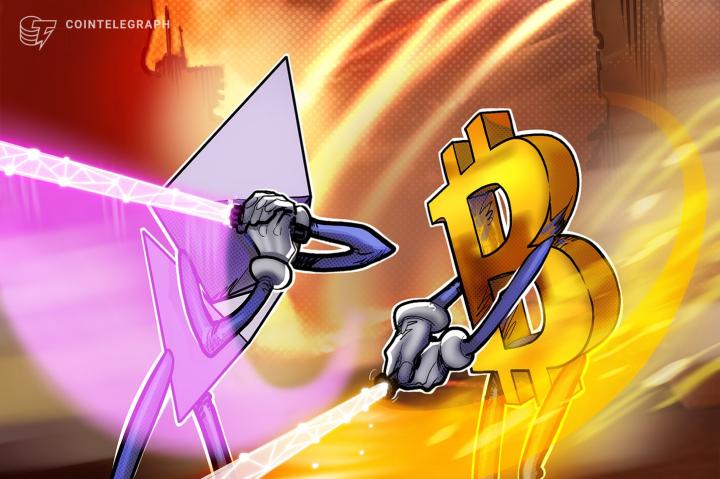Author: Mackenzie Ferguson
Translator: Bai Hua Blockchain
Ethereum enthusiasts predict that ETH will see a major revival in 2025, due to the integration of artificial intelligence, significant network upgrades, and potential improvements in U.S. cryptocurrency regulation. This optimistic outlook has sparked widespread discussion in the crypto community, laying the groundwork for Ethereum's dramatic comeback.

As one of the most influential blockchain platforms, Ethereum has always been the focus of attention, and its potential revival in 2025 has sparked heated discussions. Ethereum supporters and analysts unanimously point out that some key factors support their optimistic outlook for Ethereum's bright future. These factors include the innovative integration of AI agents into its ecosystem, which will give rise to new decentralized applications and diversified use cases, such as automated trading and personalized services.
In addition, the platform is also planning a series of important network upgrades aimed at improving Ethereum's scalability, security, and efficiency. Although the specific details of these upgrades have not yet been disclosed, they are typically implemented through Ethereum Improvement Proposals (EIPs) and necessary hard forks, which are crucial for meeting the dynamic needs of the blockchain.
The expected changes in U.S. regulatory reform are particularly crucial, as favorable policy changes may pave the way for more widespread institutional adoption of Ethereum. Clearer guidance in areas such as cryptocurrency classification and taxation may lower the entry barriers for businesses and investors, making Ethereum a more attractive investment choice. This regulatory evolution may also stimulate more innovation, reduce compliance-related concerns, and promote the healthy development of the ecosystem.
Furthermore, the global landscape is also influenced by broader trends, such as the approval of Bitcoin ETFs and the maturation of Layer 2 solutions, which have a positive impact on the overall crypto market and provide fertile ground for Ethereum's growth. Additionally, initiatives like the Ethereum Shanghai upgrade have activated the staking mechanism, increasing participation and are expected to drive ecosystem growth in the coming years.
Ethereum's technological advancements have garnered public enthusiasm, and experts are generally optimistic about significant improvements in areas such as account abstraction, Layer 2 interoperability, and user experience. While excitement surrounds the potential price appreciation and technological progress, a balanced perspective also acknowledges that regulatory and market challenges may impact Ethereum's future development. The interplay of these factors sets the stage for Ethereum to face both opportunities and challenges in 2025.
1. The Revival of Ethereum: Potential in 2025
The trajectory of Ethereum's development in 2025 has become a topic of heated discussion among crypto enthusiasts and analysts, with many predicting a significant revival. One of the key factors driving this optimistic outlook is the planned integration of Artificial Intelligence (AI) agents into the Ethereum ecosystem. These AI agents are expected to fundamentally transform decentralized applications and services by enabling features such as automated trading and personalized recommendations. This not only will expand Ethereum's functional capabilities but also promote its adoption across various industries, thereby enhancing its value and breaking beyond the traditional boundaries of digital contracts and transactions.
Furthermore, Ethereum's regular network upgrades, through ongoing Ethereum Improvement Proposals (EIPs) and hard forks, are expected to enhance its scalability, security, and efficiency. These technical improvements are crucial for maintaining Ethereum's competitive edge and attracting developers and investors. Industry discussions often emphasize the potential impact of these upgrades on the overall network performance, making them a cornerstone of Ethereum's strategic positioning for 2025.
U.S. regulatory reform is another important factor in the Ethereum revival expectations. Favorable regulatory policies may pave the way for institutional investment and adoption, as clearer compliance and classification guidelines make it easier for major financial entities to enter and participate. This regulatory stability may echo the global standards set by the EU's MiCA regulation, potentially prompting the U.S. to enact similar progressive policies, creating a ripple effect that drives the adoption of the Ethereum network.
The combination of these factors - innovative AI capabilities, robust network upgrades, and progressive regulatory measures - collectively paint a hopeful picture for Ethereum's journey towards 2025. The potential for high valuations and the increasing ubiquity of crypto technologies in everyday applications form the foundational narrative for Ethereum enthusiasts and stakeholders' future outlook.

2. AI Agents and Ethereum: Transformative Potential
The convergence of Artificial Intelligence (AI) agents and Ethereum represents the fusion of two powerful technologies, heralding a redefinition of the decentralized application (dApp) landscape. AI agents bring automation and advanced decision-making capabilities, enabling the next generation of dApps to autonomously execute complex tasks. Within the Ethereum ecosystem, this synergy is expected to attract developers, particularly those seeking to leverage AI to create innovative solutions, especially in areas like automated trading systems and personalized financial services. As these AI agents become increasingly integrated into Ethereum, they have the potential to expand Ethereum's functionality, providing users with unprecedented levels of interaction and personalization. This will drive Ethereum's mainstream adoption, positioning it as a transformative force in the blockchain and AI industries in 2025 and beyond.
1) Network Upgrades: A Key Factor in Ethereum's Revival Major network upgrades are one of the key factors driving the potential revival of Ethereum. These upgrades, driven by Ethereum Improvement Proposals (EIPs), are crucial for enhancing the platform's scalability, security, and overall efficiency. The planned upgrades promise to address the current network's limitations, making it more robust and user-friendly. These improvements are expected to meet the growing user demands, foster developer activity, both of which are essential for Ethereum to achieve its goal of being a leading blockchain platform. As Ethereum undergoes these transformations, the network will be better equipped to handle more transactions and more complex dApps, allowing it to maintain its competitiveness in the rapidly evolving crypto landscape.
2) The Potential Catalytic Effect of U.S. Regulatory Developments The development of U.S. regulations is another potential catalytic factor for Ethereum's revival. Favorable regulatory reforms can provide the much-needed clarity and stability for investors, encouraging more institutional participation in the Ethereum ecosystem. Clearer regulatory policies can simplify compliance processes for businesses, boost investor confidence, and increase capital inflows into Ethereum projects. The improved regulatory environment, aligned with global regulatory trends, suggests a more integrated and collaborative international framework for cryptocurrency regulation. This environment will provide a favorable platform for Ethereum's growth and adoption, further solidifying its critical position in the global financial landscape.
3. Planned Network Upgrades and Their Impact
As a leading blockchain platform, Ethereum is preparing for significant upcoming upgrades. Several key factors have been identified by enthusiasts and analysts as drivers for Ethereum's broader adoption and value enhancement. One important initiative is the integration of AI agents into the Ethereum ecosystem. This development is expected to facilitate the creation of new decentralized applications and services, such as automated trading and personalized recommendations, thereby enhancing Ethereum's overall functionality and use cases.
Here is the English translation of the text, with the specified terms retained and not translated:In addition to the integration of AI, Ethereum's roadmap also includes major planned network upgrades. These upgrades are typically implemented through Ethereum Improvement Proposals (EIPs) and planned hard forks, aimed at enhancing the network's scalability, security, and efficiency. Although the specific details of these upgrades have not been disclosed in the current discussions, the continued commitment to maintaining and improving the infrastructure is the cornerstone of Ethereum's competitiveness in the blockchain space.
The Impact of the Regulatory Environment on Ethereum's Growth Trajectory The regulatory environment also plays a critical role in Ethereum's expected growth trajectory. Anticipated improvements in US regulation may pave the way for increased institutional participation and investment. Such changes, which may provide clearer guidance on cryptocurrency classification, taxation, and compliance, are expected to lower the barriers for businesses and investors to engage with Ethereum, thereby fostering stronger interactions. These factors collectively drive the optimistic sentiment that Ethereum will significantly increase its prominence and utility by 2025.
4. Regulatory Environment: Expected Improvements in the US
The evolving regulatory landscape in the US has a significant impact on the Ethereum ecosystem and may pave the way for its resurgence by 2025. Recent developments and proposed legislation indicate that cryptocurrencies, including Ethereum, will be met with a more favorable regulatory environment. These improvements are expected to facilitate institutional adoption and investment, which are crucial for Ethereum's anticipated growth and price appreciation.
The key to these expected regulatory improvements lies in more explicit guidance on the classification and treatment of cryptocurrencies. Within a clearer regulatory framework, businesses and investors may face less uncertainty and risk when engaging with cryptocurrencies, and many believe this change will instill greater confidence and participation from major financial institutions.
Furthermore, a stance that actively promotes innovation-friendly policies may significantly enhance Ethereum's appeal to entrepreneurs and developers, fostering more innovation within its ecosystem. This policy shift is particularly important for Ethereum's integration of AI technology and the upcoming network upgrades, which provide new avenues for the development of decentralized applications and services.
Moreover, referencing global standards, such as the European Union's Markets in Crypto-Assets (MiCA) regulation, suggests that US policymakers may draw from international models to shape their regulatory framework, potentially leading to a comprehensive regulatory system. This could position the US as a leader in cryptocurrency regulation, providing a stable environment for Ethereum to expand its use cases and adoption.
However, while these developments hold the promise of driving Ethereum's progress, stakeholders must still consider the inherent challenges posed by any regulatory changes. A balance between innovation and risk must be struck, ensuring that regulatory advancements can meet the security, efficiency, and prosperity of the entire crypto ecosystem.

5. Understanding the "Ethereum Maximalists": The Release of Optimistic Sentiment
Ethereum maximalists, or "Ethereum maxis," are those who hold a particularly optimistic view about Ethereum's future potential. These enthusiasts share the common perspective that Ethereum, as a leading blockchain platform, is poised to revolutionize various industries with its adaptability and broad application domains. As 2025 approaches, the discussions around Ethereum's resurgence have become increasingly fervent, driven by several key factors that enthusiasts see as catalysts for Ethereum's major breakthroughs.
One key factor expected to shape Ethereum's future is the integration of AI agents. This technological leap is anticipated to open new frontiers for decentralized applications and services, transforming Ethereum into a more dynamic and multifunctional platform. AI agents have the potential to introduce automated trading, enhance personalized recommendations, and expand the scope and utility of the ecosystem. Through these innovations, they aim to solidify Ethereum's position as the leading blockchain platform, potentially increasing its adoption and market value.
For the expected Ethereum resurgence in 2025, major network upgrades are crucial. Although the article does not directly list the specifics of the upgrades, Ethereum's evolutionary process of regular updates through Ethereum Improvement Proposals (EIPs) and hard forks is noteworthy. These updates aim to address the network's scalability, security, and efficiency issues, ensuring Ethereum remains competitive and resilient in the ever-changing blockchain landscape. The community's focus on continuous improvement highlights Ethereum's potential to reclaim its prominent position.
Another important factor driving this optimistic sentiment is the anticipated improvement in the US regulatory environment. Favorable regulatory changes may facilitate Ethereum's institutional adoption and investment. By providing clearer guidance on cryptocurrency classification, taxation, and compliance requirements, these regulatory improvements may lower the barriers for businesses and investors to engage with Ethereum, thereby strengthening its market position. The improved regulatory environment becomes a key part of the "resurgence" narrative for Ethereum.
While this article paints a positive picture of Ethereum's potential, it seems to be overly focused on the optimistic sentiment, without addressing potential challenges. Readers are invited to maintain a balanced perspective, considering the optimistic forecasts alongside the obstacles Ethereum may face in its resurgence process. Recognizing the coexistence of potential challenges and positive prospects is crucial for a comprehensive understanding of Ethereum's dynamics on the path to 2025.
6. The Impact of Key Milestones on Ethereum
Ethereum has experienced numerous challenges and milestones in the past, and the anticipated resurgence in 2025 has analysts and enthusiasts alike filled with anticipation. One of the key milestones that may impact Ethereum's future is the integration of AI agents within its ecosystem. This integration is expected to open new frontiers for decentralized applications, potentially giving rise to innovations such as automated trading or personalized recommendations, significantly expanding Ethereum's functionality and attracting a wider audience.
The planned network upgrades are another factor that may have a significant impact on Ethereum's development trajectory. Although the specific details of future upgrades are not always explicitly stated, Ethereum is known for its regular improvements through Ethereum Improvement Proposals (EIPs) and hard forks. These upgrades aim to enhance the network's scalability, security, and efficiency, further solidifying Ethereum's position as a leading blockchain platform. These advancements are crucial for addressing the growing demands and increasingly complex services built on the Ethereum network.
The regulatory environment is also expected to play a pivotal role in Ethereum's potential success by 2025. Particularly in the US, the anticipated regulatory improvements may provide a clearer framework for the use, classification, and taxation of cryptocurrencies. This could lead to increased institutional investment and adoption, providing a more stable environment for Ethereum's growth. Favorable regulatory policies may pave the way for greater participation from institutional investors and businesses, further integrating Ethereum into the mainstream financial system.

7. Expert Perspectives: Diverse Views on 2025
The year 2025 holds both promise and uncertainty for Ethereum, with various experts offering different perspectives on its potential development. At the core of these discussions are the significant technological advancements, particularly the integration of AI agents. These advancements are expected to drive the development of innovative decentralized applications, enhancing Ethereum's multifunctionality and potentially driving adoption across diverse sectors. These innovations may become the key forces behind Ethereum's regained momentum, as emphasized by the enthusiastic "Ethereum maximalists."
Here is the English translation of the text, with the specified terms preserved:Another key factor is the series of planned network upgrades. These improvements are part of Ethereum's regular improvement agenda and are expected to significantly enhance the network's scalability, security, and operational efficiency. Specific improvements like the recently discussed "Pectra" upgrade are expected to alleviate network bottlenecks, improve transaction speeds, and enhance the overall user experience.
From a regulatory perspective, 2025 is also seen as a potential breakthrough year. With the potential for more favorable regulatory environments in countries like the United States, Ethereum enthusiasts are cautiously optimistic. These changes could simplify the regulatory landscape, encouraging more institutional investment and participation in the Ethereum ecosystem. This may include clearer guidance on cryptocurrency taxation and compliance issues, which are key factors for broader adoption and integration into the financial mainstream.
Public sentiment has varied in response to these forecasts. While many are excited about the technological progress and potential price appreciation - some optimistically envision Ethereum reaching $7,000 - there is also a degree of cautious optimism about regulatory developments. The potential impact of these regulatory changes could significantly transform how businesses and investors interact with Ethereum.
Although optimistic predictions are frequent, there are also skeptical voices that should not be ignored. Questions remain about whether reduced transaction fees will impact Ethereum's growth, and whether competitors like Unichain could displace Ethereum's dominance. Furthermore, discussions about the impact of this growth on the economy and ecology highlight the complexity of Ethereum's potential resurgence, challenging overly optimistic narratives. The public discourse is vibrant, with optimism, caution, and healthy skepticism shaping the rich expectations for Ethereum's future.
8. Public Sentiment: Excitement and Skepticism Coexist
The anticipation of Ethereum's potential resurgence in 2025 has elicited a range of emotional responses from enthusiasts. While many are excited about the opportunities presented by technological advancements, such as the integration of AI agents and the long-awaited Pectra upgrade, there is also a clear sense of skepticism, questioning the realism of these predictions. This complex sentiment is driven by multiple key factors that may shape Ethereum's future development.
Technological progress is at the core of the public's excitement, with developments such as account abstraction and user experience improvements through Layer 2 networks garnering widespread attention. Particularly, the concept of AI integration has resonated with those envisioning new decentralized services enabled by the Ethereum blockchain. Enthusiasts believe these enhanced capabilities can solidify Ethereum's position as a leader in the blockchain industry.
However, the enthusiasm is tempered by those who remain skeptical about the overly optimistic price predictions and the feasibility of technological breakthroughs. Critics question the ambitious price targets (ranging from $7,000 to $10,000) and the potential impact of reduced transaction fees on Ethereum's economic model. Additionally, some express concerns about the competition from emerging blockchain platforms like Unichain, which they believe may surpass Ethereum's progress.
Regulatory developments also influence public outlook. There is optimism about the potential for regulatory clarity, particularly from policy changes in the United States or supportive governments, which bolsters confidence in a more favorable environment for Ethereum's growth. However, regulatory uncertainty remains a significant concern, potentially impacting market dynamics and the flow of institutional investment.
Overall, public sentiment is a complex interplay of excitement and caution. While technological innovations and potential regulatory easing offer hope, skeptics serve as a reminder to maintain prudence, fearing economic realities or unforeseen obstacles that may constrain the anticipated growth. As the anticipation builds, the coming years will undoubtedly be a critical period for Ethereum and its position in the cryptocurrency landscape.

9. Future Impact: Economic, Social, and Political Implications
Ethereum's continued evolution, marked by network upgrades and AI integration, portends transformations across multiple domains by 2025. One of the most significant economic impacts is the potential surge in institutional investment, primarily driven by enhanced regulatory clarity and the prior approval of a BTC ETF. This shift is expected to increase the appeal of cryptocurrencies like Ethereum to large-scale investors, potentially driving their asset prices to new highs, estimated between $7,000 and $10,000. This growth could significantly boost investor portfolios and stimulate the expansion of the decentralized finance (DeFi) ecosystem. Furthermore, the increased tokenization of assets may redefine traditional financial systems, with the emergence of new financial products like "internet bonds," presenting both opportunities and challenges, potentially providing alternative investment avenues.
10. Technological Advancements and Future Challenges
Ethereum's potential resurgence in 2025 has garnered close attention from enthusiasts and analysts. Multiple factors have fueled this optimistic sentiment, including the integration of AI agents into the Ethereum network, the planned significant network upgrades, and the anticipated improvement in cryptocurrency regulations in the United States. These developments are expected to expand Ethereum's capabilities, making it more attractive to users and investors.
Particularly, AI agents are poised to play a crucial role, enabling new decentralized applications and services on the Ethereum network. These applications may include automated trading systems and personalized recommendations, enhancing Ethereum's multi-functionality and use cases. Thus, the integration of AI is driving a re-evaluation of Ethereum's potential, signaling broader adoption and higher valuations.
While not detailed in the current reports, the planned major network upgrades are expected to follow the tradition of Ethereum Improvement Proposals (EIPs) and hard forks. These upgrades typically focus on improving Ethereum's scalability, security, and efficiency, which are key elements in maintaining its competitiveness in the rapidly evolving blockchain landscape. Continued development in these areas is crucial for Ethereum to sustain long-term growth.
On the regulatory front, the anticipated improvement in U.S. cryptocurrency policy is expected to play a significant role in Ethereum's growth. Supportive regulations may lead to increased institutional participation and investment, providing the necessary clarity for businesses and investors to engage more confidently with the Ethereum ecosystem. Regulatory support can also help establish Ethereum as a reliable platform for various economic activities, driving its global acceptance.
While Ethereum's potential in 2025 has sparked excitement, it also faces challenges. Potential regulatory hurdles, network security issues, and the risk of unequal wealth distribution are key concerns that need to be addressed. A balanced approach, weighing Ethereum's promising opportunities against its risks, is crucial for stakeholders seeking to leverage its capabilities to drive economic, social, and technological progress.
11. Conclusion: Navigating Ethereum's Future
Ethereum's future is an exhilarating narrative, dependent on the progress of technological transformations and the increasingly intertwined relationships between finance, AI, and scalability. Looking ahead to 2025, Ethereum is poised to re-emerge as a titan within the blockchain ecosystem. This optimistic outlook is supported by key factors, such as the integration with AI agents, the anticipated network upgrades, and the improvement in regulatory frameworks, primarily from the United States.
The integration of AI is crucial, as it has the potential to unlock new decentralized applications and services, significantly expanding the utility of Ethereum and increasing user adoption. Automated trading, personalized recommendations, and other AI-driven applications are just some of the functionalities that Ethereum can achieve through this alliance. This evolution is expected to simplify operations within the Ethereum ecosystem, making it more appealing to tech enthusiasts and investors.
At the same time, Ethereum is anticipated to undergo significant network upgrades through Ethereum Improvement Proposals (EIPs). These upgrades aim to enhance the network's scalability, security, and efficiency. Additionally, the expected improvement in cryptocurrency regulations in the United States may further drive institutional investment, providing a clearer and safer environment for enterprises and investors to engage with Ethereum.
However, it must be acknowledged that the path to Ethereum's potential resurgence by 2025 is not without challenges. Regulatory hurdles, network security threats, and economic inequality issues pose real risks to Ethereum's progress. Stakeholders should strike a balance between optimism and caution, maintaining confidence in its technological potential while remaining sensitive to the challenges it must overcome. Whether Ethereum can truly deliver on the expectations of enthusiasts and analysts remains a multifaceted question that will gradually unfold as the ecosystem progresses.
Link to the article: https://www.hellobtc.com/kp/du/12/5609.html
Source: https://opentools.ai/news/ethereum-set-to-rebound-in-2025-why-maximalists-are-buzzing







